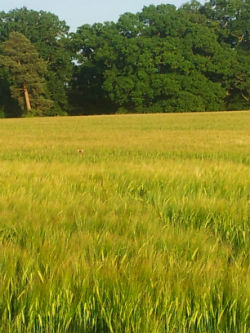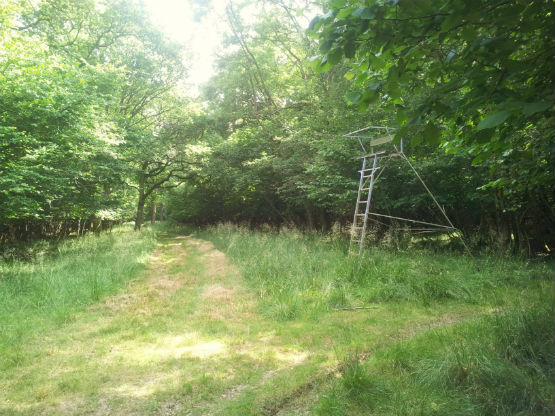Peter Jones offers some tips for summer Deer Stalking and discusses the use of Neck Shot’s in high cover.

This time last year with the wettest summer in a hundred years I found myself writing about my concerns that the Roe Rut would be delayed. What a difference a year makes! This year I find myself speculating that the Roe Rut may even come early due to the fact that the UK has been experiencing the longest period of sustained hot weather in seven years.
So how has this affected the Roe Buck? Well to be frank things so far are pretty much as expected. Only a day or so ago I watched a Roe Doe and Roe Buck share the same field of standing Barley both showing precious little interest in each other. No Rut yet it would seem and with this attitude to mating I didn’t even try the Buttalo.
A few days however can make a big difference. In line with my rule about not calling until at least the 20th July I am out this Sunday 21st stalking in Sussex and I shall be giving the ‘Buttalo’ its first trial run of the season. I will then be out again Monday and Tuesday stalking in Hampshire. Rest assured that as promised as soon as I get a ‘tickle’ I'll post my findings.
(Below: Glass fields carefully sometimes all you will see is ears poking above the parapet!).
 For many stalkers of other species Summer Stalking can be an alien concept. Cover is high and many shots are taken over substantially shorter distances. On average I would anticipate that I shoot most Roe buck at a distance of no more than around 50 yards. Provided wind direction is right it is astonishing how close you can get to these animals and this is particularly true of the young.
For many stalkers of other species Summer Stalking can be an alien concept. Cover is high and many shots are taken over substantially shorter distances. On average I would anticipate that I shoot most Roe buck at a distance of no more than around 50 yards. Provided wind direction is right it is astonishing how close you can get to these animals and this is particularly true of the young.
As such Summer Stalking requires very different tactics to winter stalking. High seats are of course a great option and are undoubtedly the most popular means of hunting Deer during the course of the summer. The high seat allows for better visibility over long grass and standing crops along with the added bonus of being less visible due to the elevated position.
Don't be fooled however into thinking that deer don’t look up! I have heard people speak this nonsense on several occasions and it is simply not true. It is only that their focus is generally earthward. Move around too much in your high seat and the deer will spot you just as assuredly as they would if you were on the ground.
If you do choose to stalk your Roe Buck on foot, there are a few other tips that are worth remembering. Firstly if you have fields of standing crop then always glass carefully down the tram lines made by the tractor tyres. All Deer and especially the smaller species such as Roe & Muntjac love to use these routes as highways around their territory. It is hard work for a little deer to make progress through standing crops and usually when pushed this is done in great leaps. Roe will much more happily make progress less impeded along the unsown tractor markings.

(Above: High seats can be invaluable to Deer Management during the summer months.)
Another point to make is that deer feel very much more comfortable when they are partially concealed in high cover. With their bodies below the height of the crop/grass deer will very often sit tight and watch you pass with only their heads or sometimes ears poking above the parapet!
Take advantage of this and scan these fields carefully, you will be amazed how often from a supposedly unpopulated field a pair of ears or antlers will suddenly emerge. Drop down and pop up where you need to but be careful, deer don’t stay in one place for too long and so by the time you reach your vantage point they may have moved on!
Finally a word of caution. Very often all you will see of your Buck is the head as it pops up to take a look around at its surroundings and gauge its position. Don’t be tempted to take a head shot! It is just not worth it. I have seen head shots go badly wrong and trust me you don’t want that on your conscience or the accompanying sick feeling in the pit of your stomach knowing that you have badly injured such a beautiful creature.
I am not suggesting that you always need wait for a broadside heart/lung shot or that you need see all of the animal before taking a shot. Whilst the DSC1 manual suggests this as good practice it is rarely plausible with this type of stalking. Provided you have observed your deer for any signs of sickness, such as drunkenness from Oil seed Rape or the like, and are sure that there are no other deer behind your beast then it is often appropriate to take a neck shot.
As I say deer stalking in the summer months is usually over much shorter distances and so here neck shooting and its requirement for greater accuracy is the exception to the rule and will represent the few opportunities over the course of a year when this shot placement is acceptable. If however you are not 100% sure of your capabilities then refrain.
One final note, a deer that has been neck shot may collapse from temporary paralysis inflicted by the passing bullet. Be sure to confirm death with the eye blink test and be prepared to bleed the animal or dispatch it promptly if it has not expired.



















